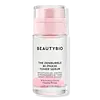What's inside
What's inside
 Key Ingredients
Key Ingredients

 Benefits
Benefits

 Concerns
Concerns

No concerns
 Ingredients Side-by-side
Ingredients Side-by-side

Water
Skin ConditioningPropanediol
Solvent1,2-Hexanediol
Skin ConditioningCentella Asiatica Extract
CleansingGlycerin
HumectantButylene Glycol
HumectantSodium Citrate
BufferingEthylhexylglycerin
Skin ConditioningAdenosine
Skin ConditioningCitric Acid
BufferingDisodium EDTA
Portulaca Oleracea Extract
Skin ConditioningAmaranthus Caudatus Seed Extract
Skin ConditioningUlmus Davidiana Root Extract
Skin ConditioningActinidia Arguta Fruit Extract
Skin ConditioningMadecassoside
AntioxidantTocopherol
AntioxidantWater, Propanediol, 1,2-Hexanediol, Centella Asiatica Extract, Glycerin, Butylene Glycol, Sodium Citrate, Ethylhexylglycerin, Adenosine, Citric Acid, Disodium EDTA, Portulaca Oleracea Extract, Amaranthus Caudatus Seed Extract, Ulmus Davidiana Root Extract, Actinidia Arguta Fruit Extract, Madecassoside, Tocopherol
Water
Skin ConditioningButylene Glycol
HumectantDiphenyl Dimethicone
EmollientDimethicone
EmollientPentylene Glycol
Skin ConditioningSodium Chloride
MaskingAgastache Rugosa Extract
AntimicrobialMoringa Oleifera Seed Oil
EmollientCentella Asiatica Extract
CleansingEclipta Prostrata Extract
Skin ConditioningCitrus Limon Peel Oil
MaskingLavandula Angustifolia Oil
MaskingCananga Odorata Flower Oil
MaskingEucalyptus Globulus Leaf Extract
PerfumingCitrus Aurantium Dulcis Peel Oil
MaskingMelia Azadirachta Leaf Extract
Skin ConditioningSodium Phytate
1,2-Hexanediol
Skin ConditioningDisodium EDTA
Sodium Citrate
BufferingCitric Acid
BufferingPhenoxyethanol
PreservativeLimonene
PerfumingCitronellol
PerfumingLinalool
PerfumingWater, Butylene Glycol, Diphenyl Dimethicone, Dimethicone, Pentylene Glycol, Sodium Chloride, Agastache Rugosa Extract, Moringa Oleifera Seed Oil, Centella Asiatica Extract, Eclipta Prostrata Extract, Citrus Limon Peel Oil, Lavandula Angustifolia Oil, Cananga Odorata Flower Oil, Eucalyptus Globulus Leaf Extract, Citrus Aurantium Dulcis Peel Oil, Melia Azadirachta Leaf Extract, Sodium Phytate, 1,2-Hexanediol, Disodium EDTA, Sodium Citrate, Citric Acid, Phenoxyethanol, Limonene, Citronellol, Linalool
Ingredients Explained
These ingredients are found in both products.
Ingredients higher up in an ingredient list are typically present in a larger amount.
1,2-Hexanediol is a synthetic liquid and another multi-functional powerhouse.
It is a:
- Humectant, drawing moisture into the skin
- Emollient, helping to soften skin
- Solvent, dispersing and stabilizing formulas
- Preservative booster, enhancing the antimicrobial activity of other preservatives
Butylene Glycol (or BG) is used within cosmetic products for a few different reasons:
Overall, Butylene Glycol is a safe and well-rounded ingredient that works well with other ingredients.
Though this ingredient works well with most skin types, some people with sensitive skin may experience a reaction such as allergic rashes, closed comedones, or itchiness.
Learn more about Butylene GlycolCentella Asiatica Extract (Centella) is derived from an herb native to Southeast Asia. It is famous for its anti-inflammatory and soothing properties.
Centella is rich in antioxidants and amino acids, such as Madecassic Acid and Asiaticoside.
Studies show the compounds in centella help with:
The combination of all these properties makes centella effective at soothing, hydrating, and protecting the skin.
Other great components of centella include Vitamin A, vitamin C, several B vitamins, and Asiatic Acid.
Fun fact: Centella has been used as a medicine and in food for many centuries. As a medicine, it is used to treat burns, scratches, and wounds.
Learn more about Centella Asiatica ExtractCitric Acid is an alpha hydroxy acid (AHA) naturally found in citrus fruits like oranges, lemons, and limes.
Like other AHAs, citric acid can exfoliate skin by breaking down the bonds that hold dead skin cells together. This helps reveal smoother and brighter skin underneath.
However, this exfoliating effect only happens at high concentrations (20%) which can be hard to find in cosmetic products.
Due to this, citric acid is usually included in small amounts as a pH adjuster. This helps keep products slightly more acidic and compatible with skin's natural pH.
In skincare formulas, citric acid can:
While it can provide some skin benefits, research shows lactic acid and glycolic acid are generally more effective and less irritating exfoliants.
Most citric acid used in skincare today is made by fermenting sugars (usually from molasses). This synthetic version is identical to the natural citrus form but easier to stabilize and use in formulations.
Read more about some other popular AHA's here:
Learn more about Citric AcidDisodium EDTA plays a role in making products more stable by aiding other preservatives.
It is a chelating agent, meaning it neutralizes metal ions that may be found in a product.
Disodium EDTA is a salt of edetic acid and is found to be safe in cosmetic ingredients.
Learn more about Disodium EDTASodium Citrate is the sodium salts of citric acid. In skincare, it is used to alter pH levels and acts as a preservative.
Its main functions are to maintain the pH of a product and neutralize metal ions.
The acidity of our skin is maintained by our glands and skin biome; normal pH level of skin is slightly acidic (~4.75-5.5).
Being slightly acidic allows our skin to create an "acid mantle". This acid mantle is a thin barrier that protects our skin from bacteria and contaminants.
Learn more about Sodium CitrateWater. It's the most common cosmetic ingredient of all. You'll usually see it at the top of ingredient lists, meaning that it makes up the largest part of the product.
So why is it so popular? Water most often acts as a solvent - this means that it helps dissolve other ingredients into the formulation.
You'll also recognize water as that liquid we all need to stay alive. If you see this, drink a glass of water. Stay hydrated!
Learn more about Water